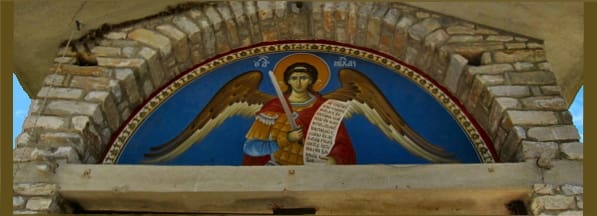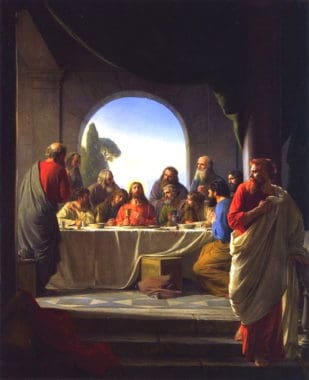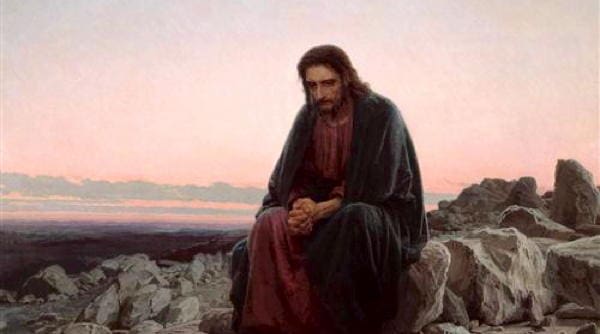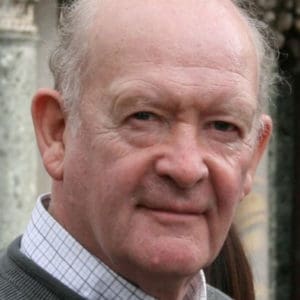Mini-Course on Prayer:
Part 4: The Way to Mystical Union
Editor’s Note: In Part 3, David Torkington wrote about how it is in giving that we receive. Today, he will introduce the way to mystical union and talk about ecstatic joy, how Christ prayed, the language of love, mystical revelations, and praying without ceasing.
If you are beginning a journey upon which your whole future depends, it is of paramount importance to understand precisely where you are going. When you begin to pray seriously St Teresa of Avila makes it clear that your destination is what she called, the Mystical or Spiritual Marriage. The Greek Fathers called this same destination divinization or theosis.
 In order to understand the way ahead, imagine a great classical archway that rises on two sides and meets at the centre in the keystone at the apex of the arch. The left side represents vocal prayer, the right side contemplative prayer that begins with meditation. In a balanced spiritual life both grow and rise to perfection simultaneously meeting in the keystone which is Christ. Both are essential in an authentic life of prayer, as can be seen in the life of Our Lord himself.
In order to understand the way ahead, imagine a great classical archway that rises on two sides and meets at the centre in the keystone at the apex of the arch. The left side represents vocal prayer, the right side contemplative prayer that begins with meditation. In a balanced spiritual life both grow and rise to perfection simultaneously meeting in the keystone which is Christ. Both are essential in an authentic life of prayer, as can be seen in the life of Our Lord himself.
How Christ Himself Prayed
We know for a fact that he used vocal prayers from his earliest years and continued to use vocal prayer to the end of his life, whilst at the same time being totally engaged in mystical contemplation. We know that he prayed using vocal prayer at least five times a day, if not more, with his disciples, at  home, at meal times, whilst travelling, as well as in the Synagogue and the Temple. However, from the moment he was born into this world he was, in his divine nature, totally engaged at all times in contemplating the infinite loving Father who sent him and to whom he would return with as many as would follow him. At times he would have to retreat to lonely places totally alone onto the mountain side, into the inner room, into the garden ‘where it was his custom to pray’. Here he would have longer periods of time to relish what he was receiving from his loving Father at all times and to allow the love that he was receiving in his divine nature to percolate through, ever more fully into his human nature. In this way, he was enabling the two forms of prayer to become one, in what came to be called ‘the prayer without ceasing’ which reaches its consummation in the mystical marriage.
home, at meal times, whilst travelling, as well as in the Synagogue and the Temple. However, from the moment he was born into this world he was, in his divine nature, totally engaged at all times in contemplating the infinite loving Father who sent him and to whom he would return with as many as would follow him. At times he would have to retreat to lonely places totally alone onto the mountain side, into the inner room, into the garden ‘where it was his custom to pray’. Here he would have longer periods of time to relish what he was receiving from his loving Father at all times and to allow the love that he was receiving in his divine nature to percolate through, ever more fully into his human nature. In this way, he was enabling the two forms of prayer to become one, in what came to be called ‘the prayer without ceasing’ which reaches its consummation in the mystical marriage.
Towards Ecstatic Joy
We do not have a divine life like Jesus but we do have an inner life that can develop into a contemplative life. This contemplative life takes us up and into Christ’s own contemplation of his Father that began on earth, and which continues now in heaven. Here our contemplation is fitted into his contemplation, where his ecstatic joy becomes our ecstatic joy too. But let us begin at the beginning with the left hand side of the archway in my analogy. Then I will return to the right hand side, showing how meditation comes to its summit in what some have called acquired contemplation, or the prayer of simple regard, that, under the guidance of the Holy Spirit, develops into the God-given contemplation that rises through purification into the Mystical or Spiritual Marriage that St Teresa of Avila describes in her masterwork The Interior Castle.
When the language of love leads to mystical Union
Most of us, like Jesus himself, are taught set prayers by our mothers that we use for the rest of our lives. We add to them and are taught further prayers and devotions like the Rosary, the Stations of the Cross and innumerable other pious practices. Then, as we progress in the spiritual life, what were at first set prayers that we used to recite, are put into our own words as our intimacy with Christ deepens. Jesus himself made it clear that he wants us to become his brothers and sisters. He even [went] further when he said at the Last Supper that he wants us to become his friends. As this realization begins to register, vocal prayer understandably becomes correspondingly deeper and deeper and more and more intimate. Then finally the most profound realization of all begins to dawn. Christ wants this friendship to be as close as that of married couples, only even more penetrating, because as Jesus said at the Last Supper, “If anyone loves me he will keep my word, and my Father will love him, and we shall come to him and make our home within him” (John 14:23). This profound realization leads to deeply personal encounters with Christ in the language of love.
Mystical Revelations
The more you become acquainted with the lives of the saints the more you will become aware of the mystical dialogues that took place between them and their ‘Tremendous Lover’. Some of these, like the dialogues of St Catherine of Siena, were written down. Sometimes Christ would appear to them in person with revelations that were not just for them personally, but for the rest of us, like the revelation to St Francis of Assisi about the primacy of love, and the revelation to St Margaret Mary about that same primacy of love, as embodied in the Sacred Heart. The point I want to make is that when vocal prayer is taken seriously and deepens daily, it becomes what the Divine Office is meant to be for priests and religious.
The Prayer Without Ceasing
 If our daily vocal prayers are genuinely inspired by the Holy Spirit, they will automatically mirror characteristic themes such as sorrow for sin, expressions of faith, sacrifice, offerings and acts of praise, thanksgiving and adoration that are the very essence of the Mass. Just as the act of worship opens the community to receive the fullness of God’s love in the Mass, so they also open up everyone to that same love in the daily personal prayers that enable our whole lives to become the Mass. In other words, the place where we offer minute by minute, hour by hour, day by day, all we say and do, all our successes all our failures, all our joys, and all our sorrows and sufferings, to God through Jesus. In other words, for the man or woman of faith, every moment is the moment when we both offer our selfless loving to God to receive his loving in return, in, with and through Christ in whom we live and move and have our very being. This is how every moment becomes a sacrament – the sacrament of the ‘present moment’ where time reaches out through love to touch eternity in the ‘prayer without ceasing’. Next time, I will begin to write more about vocal prayer and how it can become the very foundation of all prayer in which we can always find solace and support when the contemplative way seems to lead nowhere but into ‘dark nights’, ‘when the well runs dry’. I will then turn my attention to the prayer that begins with meditation and rises through contemplation to the heights of mystical prayer.
If our daily vocal prayers are genuinely inspired by the Holy Spirit, they will automatically mirror characteristic themes such as sorrow for sin, expressions of faith, sacrifice, offerings and acts of praise, thanksgiving and adoration that are the very essence of the Mass. Just as the act of worship opens the community to receive the fullness of God’s love in the Mass, so they also open up everyone to that same love in the daily personal prayers that enable our whole lives to become the Mass. In other words, the place where we offer minute by minute, hour by hour, day by day, all we say and do, all our successes all our failures, all our joys, and all our sorrows and sufferings, to God through Jesus. In other words, for the man or woman of faith, every moment is the moment when we both offer our selfless loving to God to receive his loving in return, in, with and through Christ in whom we live and move and have our very being. This is how every moment becomes a sacrament – the sacrament of the ‘present moment’ where time reaches out through love to touch eternity in the ‘prayer without ceasing’. Next time, I will begin to write more about vocal prayer and how it can become the very foundation of all prayer in which we can always find solace and support when the contemplative way seems to lead nowhere but into ‘dark nights’, ‘when the well runs dry’. I will then turn my attention to the prayer that begins with meditation and rises through contemplation to the heights of mystical prayer.
These ideas are developed further in my two major works on prayer – Wisdom from the Western Isles and Wisdom from the Christian Mystics, and Wisdom from Franciscan Italy that shows how deep contemplative prayer grows to perfection in the Life of St Francis of Assisi.
Editor’s Note: In Part 5, David Torkington will discuss beginning our prayer journey with vocal prayer and will offer a mnemonic to help us along the way.
+
Art for this post on the way to mystical union: Detail of “The Pearly Gates” The entrance to the Archangelou Monastery on the Greek Island of Thassos, Ronald Saunders, 24 May 2011, CCA-SA 2.0 Generic; Christ in the Wilderness, Ivan Kramskoy, 1872, PD-US author’s life plus 100 years or less; The Last Supper, Carl Heinrich Bloch, late 19th century, PD-US author’s term of life plus 100 years or less; all Wikimedia Commons.





